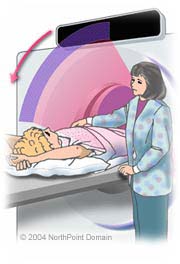CT (Computed Tomography) Scan

Basic Facts
- Computed tomography (CT) scanners use x rays to obtain horizontal and vertical cross-sectional views of internal areas of the body.
- CT scans help physicians diagnose diseases or conditions and guide instruments, such as needles or catheters, during procedures.
- The CT scanner consists of a gantry, a large, donut-shaped device; a control console; and a computer that displays images on a monitor.
- Compared with conventional x rays, CT scans have a finer degree of detail.
A computerized tomography (CT) scan, also known as a computerized axial tomography (CAT) scan, is a painless diagnostic imaging test that displays two-dimensional images of internal structures of the body on a computer screen. Patients can receive a CT scan on an outpatient basis or as part of an inpatient hospital stay. In urology, CT scans are often used to pinpoint the location of a cancerous tumor and to estimate if and where any cancer has spread. CT scans are also used in urology to locate an obstruction that might be interfering with urinary flow.PRE-TEST GUIDELINES
Patients who receive contrast material/dye will be asked to avoid foods and liquids for about 4 hours before the procedure. To obtain abdominal contrast images, patients drink a safe oral formulation of the contrast dye 1 to 2 hours before the test.
Before the test is performed, the patient changes into a hospital gown and removes all jewelry and other metal objects, which interfere with x rays. If the patient is claustrophobic, the physician may administer a sedative.
RISK FACTORS
Patients who may be unsuited for a CT scan include those who:
- Are pregnant;
- Have an allergy to contrast dye;
- Have unstable vital signs;
- Weigh more than 300 pounds; and
- Have significant problems with kidney function.
WHAT TO EXPECT
If necessary, the physician will inject the contrast material into a vein in the patient’s arm or hand. The patient lies still on a table that slides into the gantry, the donut-shaped device that houses the scanning equipment. As a medical technician operates the scanning machine in another room, he or she watches the patient and speaks to him or her through speakers in the CT scan room. The patient must remain still as the CT scanning machine operates?typically, for a few minutes. The technician may ask the patient to hold his or her breath for 20 seconds at a time.
POST-TEST GUIDELINES
There are no restrictions on a patient after a CT scan. Patients can resume normal activities immediately.
If patients have ingested a contrast agent, they are asked to drink fluids following the test for hydration and to speed excretion of the agent.
Patients who are given a sedative should arrange for a ride home after the procedure.
Copyright © 2017 NorthPoint Domain, Inc. All rights reserved.
This material cannot be reproduced in digital or printed form without the express consent of NorthPoint Domain, Inc. Unauthorized copying or distribution of NorthPoint Domain’s Content is an infringement of the copyright holder’s rights.

